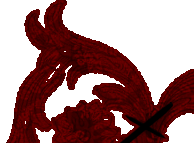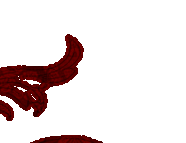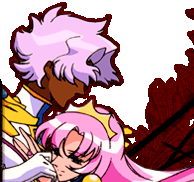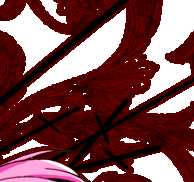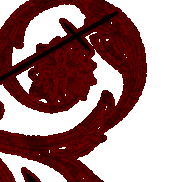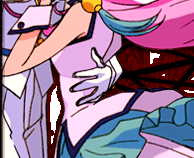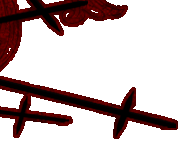
THE TALE OF THE ROSE: ANTHY AS UTENA’S ‘DARK SHADOW’
This analysis
was donated by Nicole K. Toivonen Winchester.

In my analysis of Revolutionary Girl Utena’s Apocalypse Saga (Episodes 34-39), I will examine the characters of Tenjou Utena and Himemiya Anthy as pure and noble bishōjo and demonic phallic mother. While we first see Anthy she appears as a helpless and obedient girl, but over the course of the series she is revealed to be an over-powerful bishōjo-gone-bad, an ancient witch that must be punished for her transgressions against proper feminine behaviour, and a mature woman through the sexual experience imposed on her by her abusive brother. As the ‘dark shadow’ cast by Utena’s unrelenting purity, Anthy is the villain the bishōjo must defeat, but Utena subverts the dichotomy between these two figures by rejecting all traditional shōjo and fairy tale endings for women in favour of true maturity and freedom.
“Women who can’t be princesses have no choice but to become witches,” The Shadow Girls, the Greek chorus/bunraku mashup troupe of Utena, caution their audience in Episode 34, ‘Seal of the Rose’, as they end their play. “The witch roams this world of darkness even now. Seeking the young and noble, to sacrifice them anew! Surely the light presents an obstacle to the witch, to her dominion over the dark. Beware!”54 This dialogue neatly encapsulates the dichotomy in both shōjo and fairy tales between the good and bad woman, between the phallic mother and the pure bishōjo. Women cannot be anything but one or the other; there is no state in between but death. In the scene, Utena, Anthy, and Anthy’s older brother Ohtori Akio, the Academy’s chairman, the manipulative force behind the duels and the archetypal embodiment of patriarchy in the anime,55 have just watched a retelling of Akio and Anthy’s story – the only one unaware of that fact is Utena, the bishōjo. As we soon see, what makes Anthy a ‘witch’ – a bad woman – is both her resistance and her power. In a flashback, her brother, then known as the Prince Dios, is near death from the weight of saving the “women of the world” but the crowd who comes to their door to seems entirely made of men demanding he save “our daughters.”56 Anthy then commits the sin of what Hemmann calls “personal selfishness – as expressed by her wish to devote herself just as much to her personal desires as to the welfare of the wider world – and her willingness to use her immense power to achieve her individual and “selfish” goals.”57 She tells them Dios is “mine alone” and that she has used her power to seal him “somewhere where your hands can never reach.”58 For this transgression – indeed, for saving her brother’s life – she must sacrifice herself to eternal torment, pierced by thousands of swords. No one asks why her family, and her needs are less important, or why she must suffer until a young Utena sees Anthy, eternally impaled on the Swords of Hatred, and vows to save her. Within the world of Ohtori, the world of shōjo, Anthy still has power enough to call forth a sword from both her own body and Utena’s, which is coded as a symbol of masculine sexual virility in various ways throughout the series.59 Her power, now checked, the swords that she controls and control her, and the magical phallic sword she births from her own body all mark her as the phallic mother.
Most shōjo same-sex relationships are premised on sameness, an ideal of doseai, loving one who looks like the self.60 This is not only due to aforementioned generic conventions, but also social realities which made female agency difficult in heterosexual relationships.61 There is little doseiai the primary relationship between Utena and Anthy: Utena dresses as a boy, Anthy as a girl; Anthy is foreign and dark-skinned, feminine, and reserved, Utena is Japanese and light-skinned, masculine, and outgoing. In rejecting conventions of sameness in favour of a dark-light feminine duality, Utena and Anthy are positioned as different from other shōjo pairs – different from one another, yet similar enough to be a shōjo pairing. In her position as the witch/phallic mother, Anthy is also visually Utena’s dark shadow – even their pink/violet hair colours provide aesthetically complimentary opposites. Giancarlo Cornejo suggests Anthy “may be read as black, brown, and/or South Asian by different international and regional audiences” and it is possible “the point is not to know” Anthy’s race; that her racial ambiguity is intentional.62 This ambiguity supports her role as the witch/phallic mother and shadow cast by the bishōjo’s light.
Bailey notes: “Roses are linked to female sexuality in medieval literature and psychoanalytic discourse, and Utena draws from these traditions, positioning the flower as an icon of femininity.”63 Anthy is the Rose Bride: her bond with the victor of the duels is explicitly framed as an engagement,64 it is implied that she is traded among the duelists as a trophy sex partner,65 and she is involved in an exploitative sexually abusive relationship with her brother, who is dependent on her power to continue to exert his control over Ohtori and its students.66 She has been forced into Bailey’s sexual story: muted, silenced, and violated,67 but trapped in eternal adolescence and eternal torment. According to her brother Akio, “She cannot die. Just go on suffering,”68 denied either ends of marriage or death so he can hold on to her power. She is trapped in a shōjo world but no longer belongs to it. Hemmann, when discussing the end of Magic Knight Rayearth, says: “Emeraude has renounced her sexually untainted shōjo status. When the Magic Knights finally find her, the princess no longer appears as a child but instead displays the body of an adult woman.”69 When Akio and Anthy’s sexual relationship is revealed to Utena, Utena does not see Anthy as a child in that moment. While her body is covered by her long hair, her face has changed; her eyes are narrow, dark, shaded, and adult.70 She is both naked and exposed, as her true self revealed. At this point, Utena has been seduced by Akio herself, though she believes she is in love – she is no longer sexually untainted, but her intentions still have the bishōjo’s purity. Despite Akio’s malevolent intent, he has inadvertently given them both the key to their freedom – terrible knowledge of the real world.
In shōjo anime Puella Magi Madoka Magica it is said, “the magical girl’s true task is to fight against her own adult form called “witch.””71 As the witch/phallic mother and bishōjo, Anthy and Utena have no choice but to play out a final confrontation. Hemmann discusses how, at the end of Magic Knight Rayearth, the final fight between virginal shōjo and sexually mature woman imitates the narrative patterns that preceded it in anime like Sailor Moon:
However, by representing this character dynamic as tragic, CLAMP critiques the misogynistic tendency in anime and manga to villainize older women who possess both sexual maturity and political power. Although the older woman must still die, the emotional pain caused by the manga’s refusal to allow closure to the characters or the readers demonstrates the damage caused by this trope from the perspective of a female gaze that sees women as subjects capable of growth and change rather than as mere objects to be discarded once they are past their sexual prime.72
Ikuhara and Utena also examine these misogynistic patterns through a focus on gender relations and how gender roles inhibit the development of both young women and young men. His work illustrates how these systems’ victims can also be made into its enforcers on other victims.73 Thus, Anthy is viewed with sympathy rather than approbation: she is not simply the witch/phallic mother to be destroyed, or to be destroyed and mourned, as in Magic Knight Rayearth: “Youth and innocence have defeated maturity and adult sexuality, as the conventions of shōjo romance and bishōjo fantasy dictate, but no one is happy.”74 Utena chooses a different ending.
In the final confrontation, the demonic phallic mother stabs the pure-hearted bishōjo in the back – not figuratively: with a sword, thus fulfilling her destiny.75 But Utena the bishōjo refuses to give up. However, her goal is not to destroy Akio (who she now treats as irrelevant) or Anthy the phallic mother, but to save the only person who has ever made her happy. Perper and Cornog write:
Utena loses the sword to Akio, who, in triumph, tries to open the Rose Gate behind which he believes lies the power to revolutionize the world. But the sword breaks on the stone gate, and Akio retreats in furious confusion. Utena stumbles forward, and just when we expect her to fall into Akio’s arms, she shoves him aside, true as ever to her own loyalty to Anthy. Utena’s power is no longer that of a sword-bearing goddess but a Taoist prince: she kneels before the entrance, and a single dropping tear opens the gate. The fragility of one tear can open the Way when swords cannot.76
It is not brute strength that will open the gate, but Utena’s compassion, loyalty, and love for the woman who lied to her, betrayed her, literally stabbed her in the back. Utena embraces the complexities of maturity by accepting Anthy’s flaws – and her own. As she pries open the coffin Anthy is trapped in and reaches to free her, she truly sees the witch and smiles, weeping. “Himemiya… we finally… meet.”77 Before Anthy can reach for Utena’s hand, the Swords of Hatred – the embodiment of society’s punishment for transgressive women – ‘hunt’ and separate them, and they are lost to each other. But in this, Utena has subverted the genre conventions of innocence defeating maturity and sexuality, instead allowing the characters to grow and change – perhaps the anime’s true revolution. As the series ends, Utena has been literally “expelled”78 from Ohtori and the shōjo world, and Anthy cannot stay. Utena’s loyalty, love, and acceptance has given Anthy the strength to finally ‘grow up’, reclaim her power from Akio, and leave Ohtori for a world free of patriarchal control. In her final scene, Anthy has swapped her shōjo school uniform and glasses for a more ‘adult’ fashionable outfit with an Utena-pink accent, walking through Ohtori’s gates as she vows to find her ‘prince,’ wherever she may be in the real world.79
By looking at shōjo as a site for contesting ideas about gender/sexuality, examining the lessons of shōjo, the dichotomy between shōjo and adult women, and the concepts of magic and power in shōjo, I have analyzed Utena as bishōjo and Anthy as demonic phallic mother and how the series subverts their fatal dichotomy in the finale. Revolutionary Girl Utena concluded on December 24, 1997 – Christmas Eve. It can be considered equivalent to Valentine’s Day in Japan; an opportunity for young couples to spend time together before familial obligations of the New Year. It seems fitting that Utena’s subversive final confrontation, which could be seen to celebrate the power of a woman’s love – for other women and for oneself – aired on a day dedicated to romantic love.

54 Kunihiko Ikuhara, ‘Bara no Kokuin’, Shōjo Kakumei Utena (Japan: TV Tokyo, 1997).
55 Bailey, p. 214.
56 Kunihiko Ikuhara, ‘Revolutionary Girl Utena’.
57 Hemmann, p. 65.
58 Kunihiko Ikuhara, ‘Revolutionary Girl Utena’.
59 Bailey, p. 213.
60 Deborah Shamoon, ‘Revolutionary Romance: “The Rose of Versailles” and the Transformation of Shojo Manga’, Mechademia, 2 (2007), 3–17 (p. 5). 61 Shamoon, p. 6.
62 Giancarlo Cornejo, ‘The Sedgwickian Queerness of an Anime Lesbian: Reading Revolutionary Girl Utena’, Lectora: Revista de Dones i Textualitat, 27, 2021, 211–26 (p. 217)
https://doi.org/10.1344/Lectora2021.27.10 . 63 Bailey, p. 213.
64 Cornejo, p. 212.
65 Timothy Perper and Martha Cornog, ‘In the Sound of the Bells: Freedom and Revolution in Revolutionary Girl Utena’, Mechademia: Second Arc, 1.Emerging Worlds of Anime and Manga (2006), 183–86 (p. 184). 66 Kotani, p. 168.
67 Bailey, p. 209.
68 Kunihiko Ikuhara, ‘Revolutionary Girl Utena’.
69 Hemmann, p. 65.
70 Kunihiko Ikuhara, ‘Soshite Yoru no Tobira ga Hiraku’, Shōjo Kakumei Utena (Japan: TV Tokyo, 1997). 71 Saito, p. 161.
72 Hemmann, p. 66.
73 Bridges, p. 13.
74 Hemmann, pp. 65–66.
75 Kunihiko Ikuhara, ‘Sekai no Hate’, Shōjo Kakumei Utena (Japan: TV Tokyo, 1997). 76 Perper and Cornog, p. 185.
77 Kunihiko Ikuhara, ‘Itsuka Issho ni Kagayaite’, Shōjo Kakumei Utena (Japan: TV Tokyo, 1997). 78 Kunihiko Ikuhara, ‘Revolutionary Girl Utena’. 79 Kunihiko Ikuhara, ‘Revolutionary Girl Utena’.
  |

